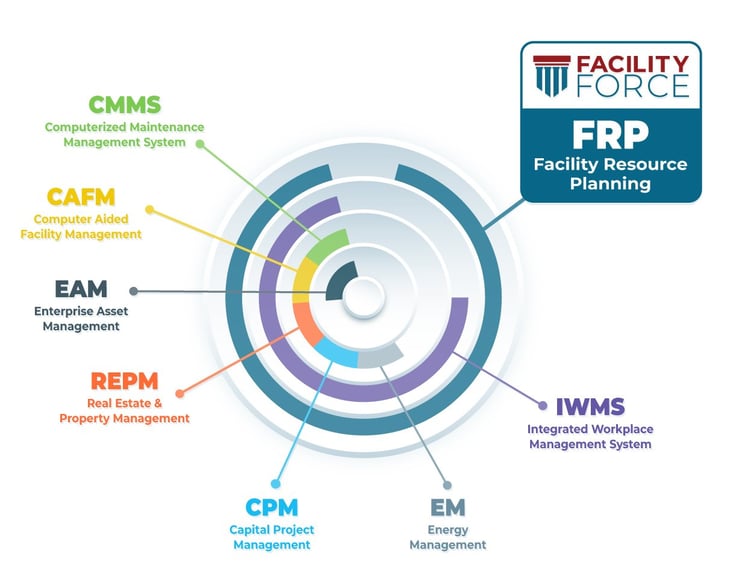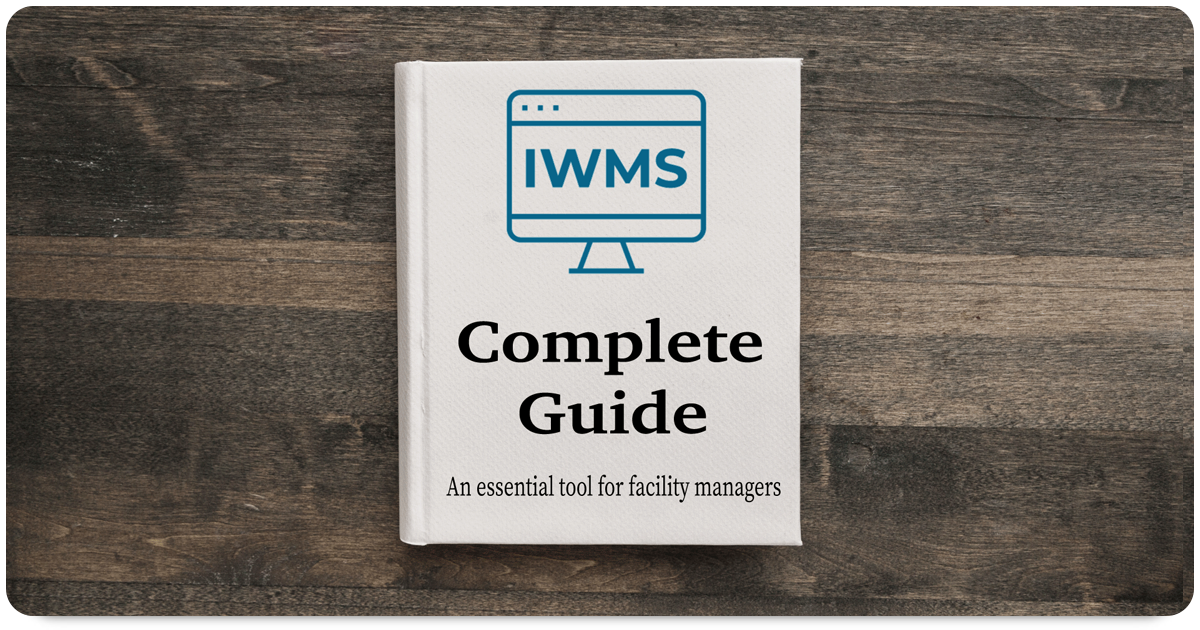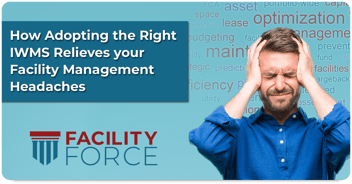Almost every article you find surrounding Integrated Workplace Management Systems (IWMS) seems identical. A little bit of text on what an IWMS actually does, and a whole lot of text on why their system is the best one out there. Most facility professionals are blown away when they fully understand the capabilities of an IWMS and how it can benefit their entire organization. For that reason, I wanted to provide a complete guide on what an IWMS is without coming off as a sales pitch. Let's take a look...
Table of Contents
- What is IWMS Software?
- How does IWMS compare to other systems?
- What are the benefits of using an IWMS System?
- What is the best IWMS?
- Conclusion
What is IWMS Software?
History of IWMS
The term IWMS was first coined by Gartner, the research and consulting service, in 2004. Since then, it has evolved in the real estate and facilities management industry to describe the concept of a comprehensive software system that integrates various aspects of managing the workplace.
Overview of IWMS
An IWMS, or Integrated Workplace Management System, is a software platform used by organizations to manage and optimize their real estate, facilities, and related assets.
An IWMS solution integrates five core functional areas for Facilities Management on a single platform. Those five core functional areas include:
1. Real Estate & Properties
Organizations may have a large portfolio of properties which leads to everyday challenges. An IWMS provides extensive value for your real estate and properties by allowing organizations to make more informed real estate decisions, such as lease renewals, portfolio management, space planning, and lease compliance.
2. Facilities
The facilities management component of an IWMS can be seen as one of the most important features. It is essential for facility leaders so they can efficiently manage their physical assets and facilities.
Key features that an IWMS provides for managing facilities:
- tracking detailed building and equipment information
- managing repairs and maintenance
- providing a means for sourcing parts and material
- streamlining work orders and the scheduling of resource
- improving customer service and the work request process
- optimizing the use of physical space
- maximizing the useful life of assets
3. Capital Planning & Projects
Every organization has renovation or construction projects whether they're large or small, and need to be well coordinated from start to finish. The Capital Planning & Projects component of an IWMS helps organizations efficiently plan, budget, execute, and track those capital projects within their real estate and facilities portfolio.
4. Operations & Maintenance
Across a large portfolio of facilities, it's not uncommon for an organization to have tens of thousands of assets or more to maintain. With that many facilities and assets, comes an infinite amount of maintenance that needs to be done. The Operations & Maintenance component of an IWMS helps organizations track their location of assets and equipment, plan their maintenance schedule by assigning work orders to maintenance personnel, and capture all the costs associated with maintenance.
5. Energy or Utilities
The Energy & Utility component of an IWMS plays a vital role in helping organizations optimize their energy usage, reduce costs, and improve sustainability. This portion allows organizations to:
- Accurately tracks utility costs, the cost of distribution systems and the maintenance of those systems to capture total energy costs for recovery.
- Define utility and virtual meters to allocate costs to specific agencies or departments
- Verify accurate billing and internal chargebacks.
- Visualize energy usage over time, detect trends and benchmark buildings with one another.
- Ensure your meter data aligns with billing data.

Read More: What is the Best IWMS Software for Government?
How does IWMS compare to other facility management software systems?
When researching facility management software systems, the results may leave you feeling overwhelmed. You're left to cut through acronyms and industry-specific vocabulary. Understanding the functionality and ambiguity among the systems can be difficult.
Some of the most popular acronyms you see in the facility management software world are CMMS, EAM, CAFM, and IWMS. "How does IWMS differ from the others?" you may be asking.
An IWMS is the most comprehensive of the facilities management platforms. It is the complete end-to-end solution, as it focuses on the 5 core functional areas of facility management and integrates a wide range of functions into a unified platform. An Integrated Workplace Management System incorporates the capabilities of various point solutions such as CMMS, CAFM, and EAM systems in a single, integrated platform.
It's important to note that while IWMS is comprehensive, it may not be the best fit for every organization. IWMS solutions are typically more expensive due to their broader functionality and integration capabilities. The cost may be justified for organizations that require comprehensive workplace management, but smaller organizations might have an easier time investing in more cost-effective solutions.
Still feeling overwhelmed? We have a jargon-free guide to facility management software systems.
Check out that article here: Facilities Management Software Jargon... Simplified

What are the benefits
of implementing an IWMS?
Centralized Information and Communication
When an organization uses multiple platforms to manage their facilities and assets they can face cross-departmental collaboration and communication problems. One department might call a building "Building 1", while another department calls it "Building A". One department claims the latest repair on an asset was 6 months ago, while another department claims the latest repair was 5 years ago. You can start to visualize and understand the problems organizations face when there's no centralized repository for information. That's where an IWMS comes in.
IWMS serves as a centralized repository for all real estate, facilities, and asset-related data. This means that all stakeholders can access the same set of accurate and up-to-date information, reducing the risk of misinformation and ensuring consistency in communication. Many IWMS platforms include collaboration tools such as messaging, notifications, and task assignments. This enables various teams and departments, such as facilities management, real estate, public works, and finance, to work together more effectively.
Efficiency
An IWMS can automate routine tasks, such as lease administration, work order management, and maintenance scheduling, improve operational efficiency and productivity, reduce manual work and errors.
Integration
An IWMS provides a single integrated system that can be used across your entire organization. Not only does it provide cross-departmental integration, but an IWMS can integrate with various systems, applications, and data sources to streamline workplace management, enhance data accuracy, and improve overall efficiency. Some of the common types of systems and data sources that an IWMS can integrate with include your HR, Purchasing, or Finance applications.
Decision Making
Using an Integrated Workplace Management System (IWMS) helps organizations make better decisions by providing access to real-time data, insights, and streamlined processes across various aspects of workplace management.
IWMS & ERP Integrations:
What is the best IWMS for you?
Now that you know the background of an IWMS and how it can help your organization, you may be wondering how to find the right one for you. Selecting an IWMS for your organization is a critical decision that can significantly impact your organization's efficiency and effectiveness in managing real estate, facilities, and assets. Here are some things to consider when selecting an IWMS:
Your Objectives
The first step in finding the right IWMS should be clearly defining your objectives and needs. Do we need a system that has mobile applications? Do we need to start with just covering one pillar of an IWMS or do we need all 5? What tools do we need an IWMS to have? These are just some of the questions you need to be asking yourself right out of the gate. During this step, you may even find out you don't need an IWMS but rather another type of system that would better fit your needs.
Stakeholders
Since an IWMS is used across an entire organization you need to involve key stakeholders from different departments, such as facilities management, real estate, finance, and IT. Gather their input and ensure that the chosen IWMS not only aligns with your requirements but also their requirements.
Scalability of the IWMS
Consider the scalability of the IWMS. Ensure that the system can grow with your organization and adapt to evolving workplace management needs. A scalable IWMS should be able to handle larger datasets, including information on properties, leases, assets, and maintenance records, without slowing down or encountering data storage limitations.Integration of the IWMS
Evaluate how well the IWMS can integrate with your existing systems and software. It should seamlessly work with your other tools, such as accounting software, asset tracking systems, and building management systems.Budget
Develop a budget for implementing and maintaining the IWMS. Be mindful of both the initial costs and ongoing subscription or licensing fees. Ensure that the system offers a favorable return on investment (ROI). This should also be the time when you decide whether you want a Software as a Service (SaaS) or on-premises solution. SaaS offers cloud-based accessibility and automatic updates, while on-premises gives more control but requires in-house IT support.Conclusion
I hope you found this guide educational, and learned how essential it is for your organization to find and implement a facility management system that aligns with your goals. If your organization is looking for a facility management system that tackles the management of your real estate, facilities, capital planning, operations & maintenance, and energy/utilities within just one system, then IWMS software is the ideal solution for you. While there is nothing wrong with using any of the facility management point solutions, an IWMS is the most comprehensive platform if you're looking for the true "enterprise" system.
"You don't want to bolt together a best-of-breed solution. You want a single database that puts the "I" in an Integrated Workplace Management System. The power of the right IWMS is the structuring and management of the detailed facilities data in a central source."
Would you like to learn more?
Related Resources:
- Facilities Management Overview
- What is the Best IWMS Software for Government?
- The State of Alaska Tackles Statewide Deferred Maintenance
- Why Capital Budgeting Software is Critical in Government Facilities
- Three Keys to Effective Space Management
- Facilities System Integration
- FacilityForce's IWMS Solution




